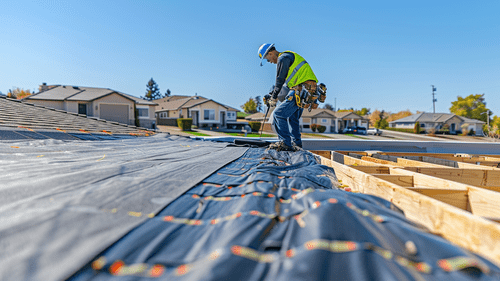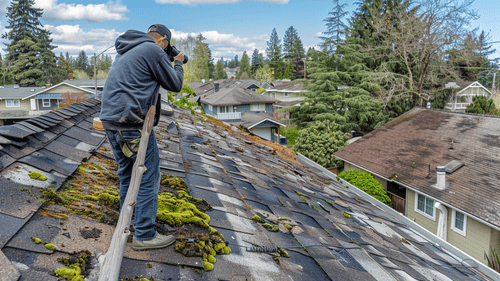Your gutters might not seem like the most exciting part of your home, but they're silently protecting you from thousands of dollars in potential damage. When water doesn't flow properly away from your home, it can wreak havoc on your foundation, landscaping, roof, and even interior walls. Many homeowners don't realize there's a problem until they notice water in the basement or peeling paint—signs that could have been prevented with regular gutter maintenance. What specific warning signs should you be watching for before small issues become major headaches?
Proper gutter function is about more than just clearing leaves twice a year. It requires understanding how your entire roof drainage system works together, from proper slope to secure attachments and strategic downspout placement. This comprehensive guide walks you through identifying common problems like mysterious overflows, structural failures, and sneaky leaks that might be happening right now above your head. We'll cover both simple fixes you can handle yourself and when it's time to call in professionals, giving you the knowledge to protect one of your biggest investments—your home.
Diagnosing Gutter Overflow Issues: Beyond Simple Clogs
When water cascades over your gutter edges like a waterfall during rainfall, you're witnessing more than just an inconvenience—it's a warning sign of potentially serious problems. Overflow typically manifests as water spilling over the front or back edges of gutters during moderate to heavy rainfall. You might notice dark water stains on siding, eroded soil beneath overflow points, or even damaged landscaping where concentrated water repeatedly falls.
The damage from persistent overflow extends far beyond aesthetic concerns. When water consistently spills near your foundation instead of being directed away through downspouts, it creates hydrostatic pressure against foundation walls. Over time, this pressure can cause cracks, shifting, and even structural instability. The excess moisture also creates perfect conditions for mold growth both inside and outside your home. Additionally, overflow that backs up under roofing materials can rot fascia boards and roof decking, leading to expensive structural repairs that could have been prevented.
While clogs from leaves and debris represent the most common overflow culprit, undersized gutters present a more complex problem that many homeowners overlook. Standard 5-inch K-style gutters handle runoff from most moderate roofs, but homes with steep pitches, metal roofing (which sheds water more quickly), or large roof expanses may require 6-inch gutters or additional downspouts. The math matters: a typical 5-inch gutter handles approximately 5,520 square inches of water flow, while a 6-inch system manages over 7,960 square inches—a 44% increase in capacity.
Climate and seasonal factors significantly impact gutter performance in ways that aren't immediately obvious. In northern regions, spring thaws can overwhelm systems as snow melt combines with rainfall. In areas with heavy pine trees, the accumulation of tiny needles creates dense, water-resistant clogs that standard cleaning may miss. Homes in regions with intense thunderstorms may experience temporary overflow even with clean gutters simply due to rainfall intensity exceeding gutter capacity for short periods—a situation that might warrant additional downspouts rather than wider gutters.
To properly diagnose overflow issues, homeowners can perform several simple tests during rainfall:
- Watch water flow patterns during various rainfall intensities to identify consistent overflow points
- Check downspout output to ensure water freely exits the system
- Inspect gutter slope using a level to verify proper drainage toward downspouts (aim for a ¼ inch slope per 10 feet of gutter)
- Measure actual rainfall amounts during overflow events to determine if the problem occurs only during exceptionally heavy rain
- Examine gutters during rainfall while wearing proper safety equipment to see if water is backing up at specific points
Addressing overflow issues promptly prevents the cascade of problems that can affect your home's foundation, landscaping, and structural integrity. The solution might be as simple as regular cleaning or as involved as installing a completely new system with increased capacity—but proper diagnosis is the essential first step toward effective resolution.
Addressing Structural Failures: Sagging, Separation, and Misalignment
Gutter sagging represents one of the most visible structural failures in your drainage system, but it doesn't happen overnight. The early warning signs appear subtly: slight dips where water pools after rain, tiny gaps between the gutter and fascia board, or fasteners that have begun to pull away from the roofline. These minor issues signal the beginning of a progressive failure that will worsen with each rainfall cycle. Gutters typically sag when the weight of accumulated water and debris exceeds the supporting capacity of hangers and brackets, especially when those components are spaced too far apart or have deteriorated.
The physics behind gutter sagging reveals why it's such a common problem. Water weighs approximately 8.34 pounds per gallon, and a 10-foot section of gutter can hold several gallons when clogged or improperly sloped. This creates significant stress on attachment points, particularly during freeze-thaw cycles when ice adds substantial weight. Once a single bracket fails, neighboring brackets must bear additional load, creating a domino effect that accelerates system failure. This explains why a small sag often progresses rapidly to a major structural issue if left unaddressed.
Proper spacing and fastening techniques make the difference between temporary fixes and lasting repairs. Professional installers typically space hangers every 24 to 36 inches, but in regions with heavy snow loads or frequent intense storms, 18 to 24 inches provides better support. The type of fastener matters significantly as well. Hidden hangers that attach to both the fascia and roof edge provide superior strength compared to spike-and-ferrule systems that tend to loosen over time. When performing repairs, replacing all hangers in a sagging section rather than just the visibly failed ones prevents the recurring cycle of progressive failure.
Gutter slope represents the most frequently overlooked aspect of proper drainage. The ideal pitch—approximately ¼ inch per 10 feet of gutter length—balances efficient water movement with aesthetic appearance. Too little slope causes water to pool and stagnate, creating weight that contributes to sagging and leaking. Excessive slope, while improving drainage, makes the tilt visibly noticeable from ground level and can cause fast-moving water to overshoot downspouts. Checking and adjusting slope during repairs ensures the entire system functions properly after addressing sagging sections.
Weather-related stresses affect gutter attachment points through multiple mechanisms that compound over time. Thermal expansion and contraction cause gutters to shift slightly with temperature changes, gradually loosening fasteners. UV exposure degrades both plastic components and the molecular structure of metals, making them brittle and prone to failure. In winter, the weight of ice and snow creates enormous vertical loads, while wind events produce lateral forces that test every connection point. These combined stresses explain why even well-installed systems eventually require maintenance, particularly at seams and corners where different sections join together.
When addressing structural failures, consider the entire gutter system rather than just the visibly affected areas. A comprehensive approach includes evaluating all attachment points, checking seams for integrity, verifying proper slope throughout the system, and ensuring downspouts remain firmly connected. This holistic perspective prevents the frustration of fixing one section only to have another fail shortly afterward, saving both time and money while providing lasting protection for your home.
Tackling Leak Points: Seams, Corners, and Connection Failures
Traditional sectional gutters contain numerous seams where individual pieces join together, creating inherent vulnerability to leakage. Each seam represents a potential failure point where water can escape, particularly as the system ages and materials expand and contract through seasonal temperature changes. These connection points rely on sealants and mechanical fasteners that degrade over time. Seamless gutters, formed on-site from continuous aluminum coil stock, eliminate many of these junction points except at corners and downspout connections, significantly reducing leak potential while providing a cleaner aesthetic appearance.
Corner leaks often develop subtly, revealing themselves through small water stains on fascia boards or barely noticeable drips during light rainfall before progressing to obvious streaming during downpours. The mitered corners of gutter systems experience particular stress because they must manage directional changes in water flow while maintaining a watertight seal. Additionally, inside corners collect more debris than straight runs, creating dams that force water against seams under pressure. Detecting corner leaks early requires careful inspection of these vulnerable areas, particularly after cleaning when the system is empty and junction points are visible.
Applying proper sealing techniques significantly extends repair longevity. High-quality silicone or butyl rubber sealants specifically formulated for gutter applications outperform general-purpose caulking in withstanding UV exposure and temperature fluctuations. Before applying new sealant, completely removing old material and thoroughly cleaning the metal surfaces with a solvent ensures proper adhesion. For optimal results, apply sealant when temperatures range between 50-80°F and no rain is expected for at least 24 hours, allowing proper curing. In areas with severe temperature swings, using sealants with greater elasticity accommodates the more extreme expansion and contraction cycles.
The connection between downspouts and gutters creates particularly vulnerable junctions where leaks frequently develop. These transition points often involve different angles and materials joining together, creating complex sealing challenges. When these connections fail, water can be directed against the foundation rather than away from it, potentially causing basement water intrusion and foundation damage. The outlet tubes that connect gutters to downspouts should extend at least 1-1.5 inches into the downspout to ensure proper flow while maintaining a watertight seal reinforced with appropriate gutter sealant.
Preventative maintenance significantly extends the life of gutter repairs by addressing small issues before they escalate. After completing any repair work, implementing a regular inspection schedule helps identify new problems early when fixes remain simple. Quarterly visual inspections from ground level can spot obvious issues, while a more thorough examination from a ladder twice yearly allows closer evaluation of seams and corners. During these inspections, gently tightening loose fasteners, removing accumulated debris, and applying sealant to minor cracks prevents them from developing into major leaks requiring extensive repairs.
The relationship between different types of leaks often creates compound problems that require comprehensive solutions. For example, a small leak at a seam may seem insignificant, but the escaping water can accelerate fascia rot, which in turn compromises gutter attachment points, eventually leading to sagging and system failure. This interconnected nature of gutter problems underscores the importance of addressing even minor leaks promptly and thoroughly, rather than applying temporary fixes that fail to resolve the underlying issues.
Optimizing Your Gutter System: Beyond Basic Repairs
Strategic downspout placement dramatically impacts overall drainage efficiency in ways that many homeowners overlook. While the standard recommendation suggests one downspout per 20-40 feet of gutter, this general guideline fails to account for roof size, local rainfall intensity, and specific landscape features. Homes in regions with frequent heavy downpours benefit from additional downspouts placed every 20 feet to prevent overflow during intense storms. Equally important is the strategic positioning of these outlets—placing downspouts near valleys where multiple roof planes meet addresses the concentrated water flow these areas generate. For maximum effectiveness, ensure downspouts direct water at least 5-10 feet away from foundations through extensions or underground drainage systems.
Splash blocks and extensions serve as critical components in a comprehensive water management strategy, particularly for homes with basement vulnerability. Standard downspouts typically deposit water within 1-2 feet of the foundation—far too close to prevent seepage issues. Properly sized splash blocks (minimum 12 inches long) disperse water energy while directing flow away from the structure. For more effective protection, consider hinged downspout extensions that can be positioned during rainfall and folded up during yard maintenance, or underground drainage pipes that channel water to daylight at a safe distance from the home. These additions prove especially valuable on properties with poor natural grading that directs surface water toward the foundation.
The marketplace offers numerous gutter guard options with varying effectiveness depending on your specific environment and debris types. Mesh screens provide affordable protection against large debris but allow smaller particles through, eventually requiring cleaning. Reverse curve systems use water surface tension to direct water into gutters while shedding debris, but they struggle with pine needles and during heavy downpours. Foam inserts block debris while allowing water through but can become breeding grounds for seeds and moss in damp climates. Micro-mesh products offer the most comprehensive protection but represent the highest investment. When evaluating options, consider your specific tree types, maintenance preferences, and local climate conditions rather than relying solely on manufacturer claims.
Integrating roof and gutter maintenance creates synergistic protection that exceeds what either system provides individually. Damaged or aging shingles shed granules that accumulate in gutters, accelerating corrosion while reducing water flow. Similarly, overhanging branches that drop debris onto roofs create ongoing gutter clogging issues that no guard system can fully prevent. A comprehensive approach includes trimming branches within 10 feet of rooflines, addressing shingle issues promptly, ensuring proper attic ventilation to prevent ice dam formation, and maintaining gutters as part of a unified roof drainage system. This integrated perspective prevents the common scenario where roof problems manifest as gutter failures.
Implementing a seasonal maintenance schedule tailored to your specific environment prevents recurring problems while extending system lifespan. Consider this quarterly approach:
- Spring: Complete cleaning after seed pods and flowers have fallen, check for winter damage to brackets and seams
- Summer: Inspect for proper flow during rainfall, address any developing leaks before fall debris arrives
- Fall: Multiple cleanings may be necessary as leaves drop, ensure downspouts remain clear for winter precipitation
- Winter: Monitor for ice dam formation and icicles, which indicate heat loss issues that affect both roof and gutter performance
Optimizing your gutter system ultimately provides protection that extends far beyond the gutters themselves. Properly managed water flow preserves foundation integrity, prevents landscape erosion, protects siding and windows from water damage, and even reduces basement humidity levels. These comprehensive benefits make gutter optimization one of the most cost-effective home maintenance investments, particularly when considering the potential repair costs associated with water damage to structural elements.
Troubleshooting the Relationship Between Roof Issues and Gutter Performance
Damaged or deteriorating shingles contribute significantly to gutter system problems through multiple mechanisms that create a cascade of issues. As asphalt shingles age, they shed granules that accumulate in gutters, creating abrasive sediment that accelerates metal corrosion while adding weight and restricting water flow. Curled or broken shingles allow water to penetrate beneath the roof surface, eventually rotting the fascia boards that support gutter attachment. This deterioration compromises the structural integrity of the entire gutter system, causing sagging and separation even with properly installed hangers and brackets. Additionally, water that bypasses damaged shingles often travels along rafters before emerging at the roofline, creating mysterious leaks that appear to originate from gutters but actually stem from roof defects.
The condition of fascia boards plays a critical yet frequently overlooked role in gutter performance. These vertical boards provide the mounting surface for most gutter systems, and their integrity directly impacts attachment security. Fascia boards commonly deteriorate from moisture exposure when gutters leak or overflow, creating a problematic cycle where gutter issues damage the very structure needed to support repairs. Signs of compromised fascia include discoloration, soft spots when probed with a screwdriver, visible rot at the edges, or paint that bubbles and peels. When performing gutter repairs, always inspect fascia condition first—installing new gutters on deteriorated fascia virtually guarantees premature system failure and wasted investment.
Ice dam formation exemplifies the complex relationship between roof condition, ventilation, insulation, and gutter performance during winter months. These damaging formations develop when heat escaping through inadequate attic insulation melts snow on upper roof sections. The resulting water flows downward until reaching the colder eave area where it refreezes, creating a barrier that traps subsequent meltwater. This trapped water can back up under shingles, causing interior leaks while creating enormous weight loads on gutters. Contrary to popular belief, gutters don't cause ice dams, but they often suffer the consequences through bent fasteners, separated seams, and pulled attachments. Addressing the root cause requires improving attic insulation and ventilation rather than merely installing heating cables on gutters.
Proper attic ventilation affects both roof longevity and gutter performance through temperature and moisture regulation. Inadequately ventilated attics create excessive heat that accelerates shingle deterioration while contributing to ice dam formation in winter. The resulting moisture issues often manifest at the roofline, where condensation can rot roof decking and fascia boards, compromising gutter attachment points. Signs of ventilation problems include excessive heat in the attic during summer, frost accumulation on roof nails in winter, and moisture staining on roof sheathing. When these conditions exist, addressing ventilation deficiencies becomes an essential prerequisite to lasting gutter repairs.
Certain warning signs indicate when apparent gutter problems actually reflect more significant roof concerns requiring comprehensive attention. Multiple leaks developing shortly after gutter cleaning suggest water intrusion through the roof rather than gutter failure. Similarly, consistent overflow during moderate rainfall despite clean, properly sloped gutters may indicate valley issues or deteriorated flashing that directs excessive water volume to specific sections. Dark staining on fascia boards above gutters points to water tracking behind the gutter system from roof defects. Recognizing these indicators helps homeowners avoid the frustration of repeated gutter repairs that fail to resolve the underlying roof problems.
The integrated nature of roof and gutter systems necessitates a holistic approach to troubleshooting and maintenance. Roof replacement provides the ideal opportunity to upgrade gutter systems, ensuring both components work together effectively with proper flashing, drip edge installation, and fascia condition. Similarly, addressing ventilation improvements during gutter work creates synergistic benefits that extend the lifespan of both systems. This comprehensive perspective prevents the common situation where focusing exclusively on one component leaves underlying issues unresolved, ultimately saving homeowners time, frustration, and significant expense.
Taking Control: Your Gutter System's Critical Role in Home Protection
Your home's gutters silently protect against thousands in potential damage, directing water away from your foundation, roof, and walls. We've explored how overflow issues can create hydrostatic pressure and foundation damage, how structural failures progressively worsen without intervention, and how leak points at seams and corners require proper sealing techniques. The relationship between your roof and gutter system is symbiotic—problems with one inevitably affect the other through damaged shingles, compromised fascia boards, ice dams, and ventilation issues.
The warning signs we've discussed—mysterious overflows, sagging sections, corner leaks, and fascia deterioration—shouldn't be ignored, as they signal potentially serious issues developing above your head. Your gutters deserve more attention than the typical twice-yearly cleaning most homeowners provide. By implementing a seasonal maintenance schedule, optimizing downspout placement, and addressing small issues before they escalate, you're not just maintaining gutters—you're protecting your entire home from water's relentless destructive power. What seems like a minor drip today could be undermining your home's very foundation tomorrow.







